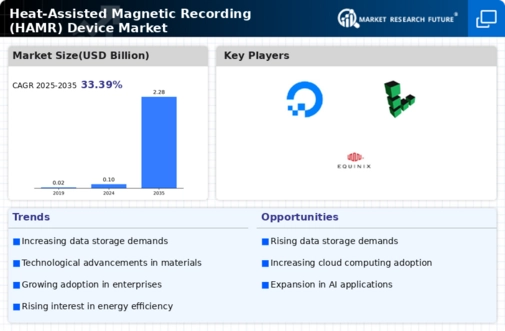Leading market players are investing heavily in research and development to expand their product lines, which will help the heat-assisted magnetic recording (HAMR) device market grow even more. Market participants are also undertaking various strategic activities to expand their footprint, with important market developments including new product launches, contractual agreements, mergers and acquisitions, higher investments, and collaboration with other organizations. To expand and survive in a more competitive and rising market climate, the heat-assisted magnetic recording (HAMR) device industry must offer cost-effective items.
Manufacturing locally to minimize operational costs is one of the key business tactics manufacturers use in the heat-assisted magnetic recording (HAMR) device industry to benefit clients and increase the market sector. Major players in the heat-assisted magnetic recording (HAMR) device industry market, including General Mills Inc., Amway, Conagra Brands Inc., Cargill Incorporated, Abbott Laboratories, Kraft Foods Group Inc., and others, are attempting to increase market demand by investing in research and development operations.
Seagate Technology Holdings PLC manufactures electronic storage devices. The company designs and markets HDDs, solid-state drives (SSD), solid-state hybrid drives (SSHDs), and hard drives. Seagate's product portfolio comprises electronic data storage products, including storage subsystems, video, and image hard disk drives, network attached storage drives (NAS), desktop drives, notebook drives, and digital video recorders. It also delivers a wide range of software solutions to semiconductor manufacturers, enterprise storage, data center, and cloud service providers. The company provides various services such as backup and data recovery services, data migration, big data analytics, data restoration, high-performance computing, and video analytics.
Seagate's products serve the requirements of enterprise, desktop, and mobile computing. The company offers products to original equipment manufacturers (OEMs), retailers, and distributors under its globally recognized brands, such as Maxtor and LaCie. In January 2022, Seagate declared it had started shipping enormous 22TB hard drives to some of its customers. The company uses shingled magnetic recording (SMR) technology to squeeze more terabytes out of its biggest industries. These highest-capacity drives provide better random read and write speeds than SMR disks but at a lower density.
Toshiba Corp is a diversified electronics, electrical equipment, and information technology enterprise. It designs, develops, produces, and sells storage devices, point-of-sale (POS) systems, energy-saving products and services, semiconductors, semiconductor manufacturing equipment, microwave semiconductors and components, tablets, home appliances products, power systems, transmission and distribution systems, and water treatment systems. It offers digital solutions, building solutions, power systems, and other social infrastructure solutions such as steam turbines for thermal power plants, wind and nuclear power generation systems, hydroelectric, secondary battery, energy supply systems, lighting, air-conditioning systems, elevators, and building and facility technologies.
In February 2022, Toshiba announced that its 30TB disk drive would arrive by 2024. The company plans to leverage its proprietary recording technologies, like FC-MAMR, MAS-MAMR, and disk stacking tech, to enhance HDD capacities to 30TB by the end of March 2024.














Leave a Comment